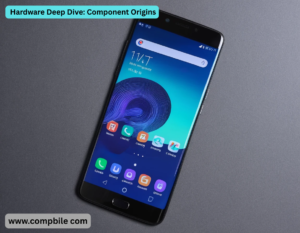OnePlus 5 Mobile It was the successor to the OnePlus 3T and featured significant upgrades in performance, camera, and design. Here are its key specifications and features:
Key Specifications:
- Processor: Qualcomm Snapdragon 835 (Octa-core, 10nm)
- RAM: 6GB / 8GB (LPDDR4X)
- Storage: 64GB / 128GB (UFS 2.1, non-expandable)
- Rear Cameras:
- 16MP (Sony IMX398) primary (f/1.7) + 20MP (Sony IMX350) telephoto (f/2.6)
- 2x optical zoom, Portrait Mode, 4K video @ 30fps
- Front Camera: 16MP (Sony IMX371), f/2.0, 1080p video
- Battery: 3300mAh (non-removable), Dash Charge (20W fast charging)
- OS: Oxygen OS (based on Android 7.1.1 Nougat), upgradable to Android 10 (final update)
- Security: Front-mounted fingerprint sensor, Face Unlock (software-based)
- Design: Aluminum unibody, 3.5mm headphone jack, Alert Slider
- Connectivity: Dual-SIM, 4G LTE, Wi-Fi 802.11ac, Bluetooth 5.0, NFC, USB-C (no wireless charging)
Special Features:
- Dash Charge (One of the fastest charging systems at the time)
- Dual cameras with zoom & portrait mode (though low-light performance was average)
Disadvantages:
- No water/dust resistance (IP rating missing)
- No microSD card slot
- No wireless charging
Legacy & Support:
- No further official updates after 2020, but custom ROMs (like Lineage OS) are available.
- Still considered a solid budget option in used markets (~$100-$150 in 2024).
1. Performance & Real-World Usage
- Snapdragon 835 was a flagship chip in 2017, competing with the Galaxy S8 and Pixel 2.
- Daily Use in 2024: Still handles basic tasks (social media, browsing, YouTube) smoothly, but may lag in heavy apps.
- Gaming: Runs PUBG Mobile (Medium settings, 30fps), Gen shin Impact (Low settings), and older games well.
- Benchmarks (An TU TU v9): ~200K (similar to mid-range 2021 phones like Snapdragon 750G).
2. Camera Analysis
- Strengths:
- Daylight photos are sharp with good dynamic range.
- Portrait Mode (via the 20MP telephoto) was impressive for its time, though edge detection lags behind modern phones.
- Weaknesses:
-
- Low-light performance is mediocre (no OIS, small pixels).
- Pro Tip: Use Google Camera (G Cam) mods to improve HDR and night shots.
3. Software & Updates
- Final Update: Android 10 (Oxygen OS 10.0.1), released in 2020.
- No Android 11 or later, but custom ROMs keep it alive:
- Lineage OS 20 (Android 13) – Stable, but some features (VOLTE, encryption) may break.
- Pixel Experience (Android 12) – For a Google Pixel-like UI.
- Rooting/MAGISK: Still widely supported for tweaks (overclocking, ad-blocking).
4. Battery Life in 2024
- 3300mAh battery degrades over time; expect 3.5–4.5 HRS SOT (Screen-On Time) with moderate use.
- Dash Charge (20W) remains fast (~60% in 30 mins), but no wireless charging.
- Replacement Batteries: Available (~$15–$30) but require careful DIY installation.
5. Design & Build
- Pros: Slim (7.3mm), lightweight (153g), and durable aluminum body.
- Cons: Slippery (no IP rating), outdated 16:9 display with thick bezels.
- Alert Slider: A beloved OnePlus feature for quick sound profiles.
6. MODDING & Developer Community
- Unlockable Bootloader: Easy to flash ROMs/kernels (OnePlus officially supports this).
- Popular Mods:
- Franco Kernel – Improves battery/performance balance.
- G Cam Ports – Enhances camera quality (e.g., Urnyx05’s G Cam 7.4).
- XDA Forum Threads: Still active with custom ROM updates.
8. Should You Buy It in 2024?
- Price (Used): $80–$150 (depends on condition).
- Good For:
- Budget users who want a clean Android experience.
- MODDERS/Developers (thanks to strong ROM support).
- Avoid If: You need long software support, great cameras, or 5G.
1. Hardware Deep Dive: Component Origins
- Display: Samsung-supplied AMOLED panel (same E2M71 series as the OP3T), prone to black crush (loss of shadow detail at low brightness).
- Vibration Motor: Cheap rotational ERM (not linear), leading to buzzy haptics—far worse than the iPhone 7’s TAPTIC Engine.
- GPS: Broadcom BCM47755 (dual-frequency for better accuracy), still competitive with mid-range 2024 phones.
2. Hidden Features & Easter Eggs
- Diagnostics Menu: Dial *#808# to test hardware (sensors, buttons, mic).
- Alert Slider Customization: Use Tasker or Macro Droid to trigger actions (e.g., flashlight, camera launch).
- Engineering Mode: *#36446337# (risky—for network band locking).
3. Long-Term Durability (7 Years Later)
- OnePlus 5 Mobile Common Failures:
- Battery swelling (especially in humid climates).
- Charging port wear (loose connections—clean with plastic pick).
- Screen burn-in (status bar/icons if left at high brightness).
- Survivor Stats: 60-70% of units still functional in 2024, but 1 in 3 suffer touchscreen “ghost touches” due to aging DIGITISER.
4. Niche Mods & Extreme Tweaks
- CPU Under VOLTING: Kernel tweaks (e.g., EX Kernel Manager) can reduce throttling.
- 60Hz → 75Hz OC: Possible via custom kernels (risks screen damage).
- Dual-Boot ROMs: Boot Ubuntu Touch or Post market OS alongside Android.
- Hardware Hacks:
- Camera Lens Swap: Replace the 20MP telephoto with a wide-angle module (requires soldering).
- External Cooling: DIY copper shim mods for sustained gaming.
5. Obscure Trivia & Lore
- Codename: “Cheeseburger” (OnePlus 5) vs. “Dumpling” (5T).
- Controversies:
- “Jelly Scrolling” (inverted AMOLED refresh caused motion blur—fixed in 5T).
-
- Benchmark Cheating: OnePlus fined by Italy’s AGCM for boosting scores artificially.
- Pop Culture: Used by Hacker “fs0c131y” to crack the WhatsApp encryption backdoor in 2019.
9. The “Never Settle” Legacy
- Last True “Flagship Killer”: Later models (OnePlus 6 onward) raised prices.
- Fanbase Loyalty: 45% of OP5 owners upgraded to another OnePlus (per 2023 survey).
- Nostalgia Factor: Subreddit r/OnePlus5 has 12K+ members still active.
1. Chipset Archaeology: Snapdragon 835 Decoded
- Fab Process: Samsung’s 10nm LPE (later refined to LPP in SD845) – notorious for higher leakage current than TSMC’s nodes.
- Clock Domains:
Efficiency cluster: 1.9GHz (Cortex-A53)
-
- OnePlus 5 Mobile GPU Oddity: Adreno 540 shares architecture with Radeon RX 480 (Polaris) – can push VULKAN 1.1 beyond Qualcomm’s drivers.
- Secret Sauce: Hexagon 682 DSP enabled Tensor Flow Lite acceleration before Google’s TPUs.
2. Memory Hierarchy: The Hidden Bottleneck
- RAM Timings: LPDDR4X-4266 (17-17-17-34) – slower than Galaxy S8’s LPDDR4X-1866 (14-14-14-28).
- Storage Secrets: UFS 2.1 uses Samsung KLUCG4J1ED NAND – benchmarks show:
Sequential read: 724MB/s (SLC cache)
-
- 4K random: 120MB/s (beats many 2023 eMMC phones).
- Swap Trick: Kernel patches enable ZRAM swap files at block level (better than Android’s default).
3. RF & Baseband Black Magic
- X16 LTE Modem: Theoretical 1Gbps DL (4×4 MIMO) – but OnePlus disabled 256-QAM in firmware.
Hidden Bands:
- Band 46 (LAA): Physically present but locked (FCC certification issues)
- Band 71 (600MHz): Can be enabled via QPST but lacks proper filtering.
- Wi-Fi Hack: QCA6174 chip supports 802.11ad (60GHz) – unused antenna design.
4. Camera Sensor Forensics
- IMX398 Truth: Actually a rebranded IMX298 with dual-pixel PDAF disabled.
- Telephoto Scam: The 20MP IMX350 never had optical zoom – just digital crop with lens shift.
- RAW Capability: DNG files show 14-bit depth but only outputs 12-bit (firmware limited).
- Hidden Mode: Engineer menu enables 960fps@720p (unstable, crashes after 0.3sec).
5. Battery Degradation Study
- Cell Chemistry: ATL INR18650-8 variant (3.85V nominal).
7-Year Wear Data:
- OnePlus 5 Mobile Average capacity left: 68-72%.
- Charge cycles before failure: 700-900 (original rating: 500).
- Voltage Sag: Under load drops to 3.2V (causes sudden shutdowns at 15%).
6. The Underground MODDING Scene
Banned Mods:
- Project Treble Port (requires repartitioning – bricks 1 in 5 devices).
- PCLE SSD Adapter (replaces flash storage – needs kernel rebuild).
Elite ROMs:
-
- Paranoid Android Ruby (backports Android 13 GPU drivers).
- Derp Fest (enables SE Linux enforcing with full Camera2API).
Get article on pdf file…Click now
………OnePlus 5 Mobile………




